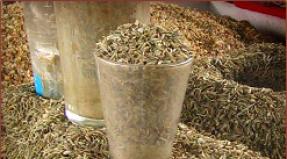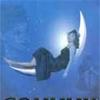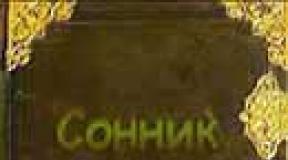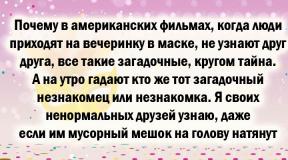Lightsaber from the stars. DIY Jedi lightsaber
Is it possible to create a lightsaber from the point of view of modern science?
- Physics
- Translation
Thanks to the extensive technical description created by the writers, we have a pretty good idea of how May be built a lightsaber. And for several decades now, millions of fans of the Star Wars universe have been dreaming of creating such technology. Let's see how close modern science allows us to create a weapon a la a lightsaber? 
This is what the “original” lightsaber looks like in cross-section.
First, let's figure out how the Jedi lightsaber works. Despite its name, this weapon's beam is not made of light. This is an erroneous term (if one can even speak of an error in this case) of the same order as “shooting star” in relation to meteoroids that burn up in the Earth’s atmosphere. Poetic, but nothing more. The most correct description of the principle of operation of a lightsaber would be the following: a plasma arc is created, which, with the help of a magnetic field and a focusing crystal, is “stretched” in the form of a long thin line. But keep in mind that there is something very similar to the force used by the Jedi and Sith to manipulate physical objects.
As an illustration from real life, here is this electric arc, which changes its shape under the influence of a magnetic field while playing music:
Another arc example:

It is quite possible to imagine how this arc is “taken” in the middle and extended by about a meter, turning into the “blade” of a sword. Although in reality this is a very difficult task, we will return to this later.
Today we already use technologies very close to the above description of the principle of operation of a lightsaber. For example, metal cutting machines in factories around the world use a “beam” of super-hot plasma (up to 40,000 degrees).

This diagram shows the design of a plasma cutter and is similar to how a lightsaber might be constructed. Unfortunately, that's where the similarities end. The arc formed is very small in size (in the diagram it is indicated by a blue line). It ignites the gas supplied under pressure, which acts as a coolant, discharging the arc energy outward.
The main “disadvantage” of a plasma cutter, from the point of view of our task, is the very small size of the arc. In the best case, it can be “stretched” to 12-15 cm. In addition, these devices consume a huge amount of electricity. The cutter nozzle must be constantly cooled by running water, otherwise it will melt very quickly. In some cutters, the gas flow acts as a cathode and the surface being cut acts as an anode. As a result, the plasma arc is relatively long and extended outside the apparatus. But in any case, such plasmatrons cannot be used as weapons. If only because you will first have to connect a high voltage cable to your opponent.
We do not yet have the technology to draw and hold an arc using a magnetic field. Even if you pull it outward from some hypothetical handle, it will be unstable, constantly deflecting to the sides in a random manner, trying to “stick” to the nearest surface.
In addition, since the arc will be an extremely elongated loop, the branches located at a small distance from each other will simply merge and the arc will shorten again. But even if we somehow solve both of the problems described, we still have others: a powerful loss of heat and the intangible, so to speak, nature of the arc, that is, with its help it is impossible to block or parry the blow of an enemy’s weapon.
Another way
It's probably worth thinking in a completely different direction. So, our task is to create a hand weapon that can cut various materials and has a luminous “retractable” blade. Today, the closest option theoretically available to us is a string of several threads consisting of carbon nanotubes. The cutting ability of the string can be imparted using a pulsating electromagnetic field and/or plasma. This kind of “energy vibro-sword” in its design will resemble a bow, because you need to somehow tighten this wire. Otherwise you will end up with a whip, not a sword.
To ensure the “retractability” of the blade, you may have to make the rigid part of the blade telescopic, and place the wire in the form of a coil in the handle. To ensure high mechanical strength, the telescopic part can also be made from carbon nanotubes. The hard part of the blade will be thin enough to follow the hot wire through the material being cut, and at the same time thick enough to withstand the blow of an enemy weapon.
To maximize the life of the cutting wire and reduce heat loss, you need to apply energy immediately before contact with the surface being cut, releasing an impulse from the handle to the tip. The threads that form the wire will gradually wear away as the charge passes from the outer layers of the wire to the core. As a result, the effect of constant ablation will be observed, which will require regular renewal of the wire, because it will be very thin. The thinner it is, the higher the cutting ability of the weapon will be.
The energy source will still be very large and may have to be carried in a backpack. It will be necessary to solve the problem of thermal insulation of the handle, including by means of a forced limitation of the time of continuous operation. Given the very high brightness of the glow of the hot wire, you will need to use special light-protective glasses. If we are talking about using the most advanced achievements of science, then glasses can also be more than just optical filters. It might be advisable to use smart glasses. While completely transparent when worn normally, they will dynamically darken or opaque only a small area of the field of view, large enough to cover the hot glowing wire.
This is what the described “energy vibro-sword” could look like as a result:

What more or less accessible (or promising) technologies would you suggest using for such handheld weapons?
Lightsaber
Designed for both "elegant combat" and ceremonial use, the lightsaber was a special weapon whose very image was inextricably linked with the world of the Jedi.
A blade whose blade is composed of pure energy emitted from the hilt, most often created by the owner of the weapon based on his own needs, requirements and style. Due to the unique balance of the sword - all its weight is concentrated in the hilt - it is extremely difficult to handle without special training. In the hands of masters of the Force, such as the Jedi or their dark cousins the Sith, the lightsaber commanded great respect, even fear. Wielding a lightsaber meant incredible skill and focus, as well as masterful dexterity and harmony with the Force.
Over millennia of use, the lightsaber became an integral part of the Jedi and their quest to maintain peace and justice throughout the galaxy. This view persisted despite many early conflicts with the Sith and Dark Jedi, who also wielded these weapons.
Story
I thought Jedi married their lightsabers.
Atton Rand, Star Wars: Knights of the Old Republic II: The Sith Lords
Since the creation of the Jedi formation on Tython after the Force Wars, around 25,000 BC. b. , ceremonial weapons were an essential part of the order. The first Knights used alloy swords, infusing them with elements of the Force during a ritual called Jedi Forging. Later, by combining advanced technology from other planets with the ritual of forging, the Jedi learned to "freeze" the laser beam, a technology that would guide the Jedi to create future lightsabers.
By the time of the Duinogwuin Confrontation around 15,500 BC. b. , the order’s research in energy technology was successful; The Jedi developed a way to generate a focused energy beam that arced back to its source in a closed curve, creating the first portable high-energy blade. These precursors to lightsabers were terribly unstable and inefficiently wasted the energy coming from the power packs attached to the belt; They could only be used for a short time before they overheated. Due to the design's limitations, the first lightsabers were merely ceremonial additions to a Jedi's attire, rarely worn and used even less often.
The lack of stability that plagued previous models was corrected over the centuries, leading to the Hundred Years' Darkness in 7000 BC. b. Clumsy and few in number siege weapons gave way to elegant and more common lightsabers. However, despite the stability, power delivery was still an issue. They still required wearing power units on the belt. The power cable connecting the belt and the sword hampered the Jedi's movements in battle, but the new, stable blade gave them a tremendous advantage in hand-to-hand combat with a well-protected enemy.
It was only during the Great Hyperspace War that the lightsaber as we know it today was created. The cluttered power cable and external power supply of older models were replaced with internal components by the time of the Gank Massacre in 4800 BC. b. . A superconductor was introduced into the design, which transformed the cyclically returning energy from the negatively charged energy flow hole back into the internal battery. With this modification, the battery only drained energy when the energy loop was broken (when the sword's blade collided with something), a centuries-old power supply problem was finally solved.
After the Great Jedi Purge, lightsabers became rare relics, highly prized by some collectors. During the years of Palpatine's Empire, some lightsabers found their way onto the black market and were sold for huge sums. They reappeared on the galactic stage with the creation of the New Jedi Order, thanks to the teachings of Luke Skywalker and the rediscovery of ancient Holocrons and teachings that were thought lost after the extermination of the Jedi.
Following the fall of Palpatine and the emergence of new Jedi, other Force-wielding groups, such as the Desanna Reborn and the Disciples of Ragnos, mass-produced the swords to arm their rapidly growing legions. In contrast, the new Jedi maintained the old traditions and rituals, using their connection to the Force to make lightsabers for themselves. The Knights of the Empire also made their own swords, ensuring that despite the same design, each sword was unique. These swords were seen as symbols of how individuality mattered less than the Empire they served.
Device
Ideally, a Jedi needs many months to create the perfect weapon, which he will keep and use until the end of his days. Once created by you, the lightsaber will be your constant companion, your tool, and your means of defense at the ready.
Luke Skywalker
The ritual of creating one's own lightsaber was an integral part of Jedi training and involved not only technological skill, but also harmony with the Force. During the days of the Old Republic, the ice caves of Ilum were used as a ceremonial site where Padawans would come to make their first lightsaber. Here and in places like this, such as the caves near the Jedi Enclave on Dantooine, the Jedi selected the best focusing crystals for themselves through meditation and connection with the Force and then completed the assembly of the sword.
Traditionally, creating a lightsaber took about a month. It involved assembling the pieces, both by hand and with the Force, and meditation to saturate the crystals. However, if absolutely necessary, the creation of a sword could be greatly accelerated. Corran Horne's first lightsaber, a dual-phase lightsaber created during his undercover work as an Invid ("Disturber") pirate, was made using this technique.
At the heart of the sword's hilt is a metal cylinder, usually 25-30 centimeters in length; however, the design and dimensions of the handle vary greatly, depending on the preferences and anatomical features of each creator. The handle shell contains complex components that create the blade and give it its unique shape. A high-power energy flow, passing through a system of positively charged focusing lenses and activators, forms an energy beam that extends from the base of the sword for about a meter and then, forming a peripheral arc, returns to the negatively charged ring-shaped depression encircling the emitter. The superconductor completes the energy loop by feeding the converted energy back into the internal battery, where the loop begins again. By adding one to three focusing crystals with different properties, you can change the length of the blade and the power of the energy output using control mechanisms built into the handle. The two crystals create a branching cyclic ignition pulse, allowing the sword to be used underwater.
It doesn't matter who creates the sword - a young padawan or an experienced master, creation always begins with the collection of the necessary components. All lightsabers contain some basic components:
- handle;
- activation button/panel;
- fuse;
- emitter matrix;
- lens system;
- power unit;
- energy source;
- charging connector;
- 1-3 focusing crystals.
Many lightsabers, such as the one carried by Zane Carrick in 3964 BC. b. , had a pressure sensor in the handle that deactivated the blade when it was released. It is worth noting that Darth Maul's double-bladed sword was not equipped with such a mechanism. Other swords were made either without a pressure sensor or with a locking mechanism that caused the blade to remain activated if the sword was thrown or dropped.
Traditionally, the crystal was the last component added. It represented the very essence of the weapon and gave it color and strength. A lot of effort and time went into choosing this most important component of the lightsaber.
Having found all the components, the Jedi began the assembly process. Due to the complexity of the technique used, the Force was designed to bind components at the molecular level. These microscopic manipulations of the components allowed the energy loop design to operate with near-perfect efficiency. It was not uncommon for a Jedi to spend weeks, even months, putting all the pieces together to make sure that every part fit exactly, and that the sword had the required length, color, and frequency of the blade. However, during the Clone Wars, it was claimed that the sword could be created in two days. In addition, someone who does not have the Force, but is quite experienced in force field technology, is capable of creating a lightsaber. Assembling a lightsaber using the Force was the final test for a Padawan to prove his connection to the Force was deep enough to be called a knight. However, at its core, a lightsaber is a portable projector of a highly targeted, high-power force field. There is nothing extraordinary in its design, except for the focusing crystals, on which the strength and special properties of each specific blade depended.
While most lightsabers look similar at first glance, a closer look reveals many design differences - hidden or overt. Due to the fact that each Jedi created his sword from scratch, it is impossible to find two identical ones. However, some Padawans made swords similar to their master's as a sign of respect.
Much knowledge about the design of lightsabers was lost during the destruction of the Jedi, but Luke Skywalker discovered the records and materials necessary to create his first sword in Obi-Wan Kenobi's hut on Tatooine.
Operating principle
First, the energy generated by the battery goes to the crystals, where it is converted into a stream of directed energy packets. It is then focused outside the sword through a positively charged energy lens at a distance set by the dial. The energy is released in a very powerful and fast stream, but it is almost instantly attracted back to the negatively charged entrance hole (which is actually impossible, since light has no electrical charge and therefore cannot react to the charge of the entrance hole). This creates a thin arc of light beam. The rest of the “thickness” of the blade is only the result of the contact of the beam and the air around it, simply an optical effect (however, if you look closely in the films, you will notice that the swords contact just along the border of such an “effect.” That is, the effect still provides resistance) . The returning beam is redirected according to a special circuit to the battery, where it recharges it, thus not wasting energy on its existence (which, however, is not true - it glows, which means it dissipates energy), except for those moments when the blade cuts something, or rather - melts, or collides with another light blade.
From the above, it becomes clear that the light blade has no mass. This gives an objective advantage in fencing, and coupled with the ability to melt even the hardest materials, it generally gives a person wielding a lightsaber unique capabilities. But there are a few more very important facts about the lightsaber that anyone interested in this technology should know.
Souvenir swords are often equipped with a “blade” tube that glows from the inside, and the handle makes a characteristic hissing sound.
- The arc of the light blade creates a powerful gyroscopic effect that causes the handle to literally fly out of your hand, so controlling it requires great skill and skill. That is why a lightsaber in the hands of an untrained beginner poses more danger to the fighter himself than to his opponent.
- Since a lightsaber uses the same technology as a blaster (damaging, albeit more powerful, but still with the same physical properties, positively charged beams of energy), the blade of a lightsaber has the ability to reflect shots from blasters. If you can predict the target of the shot (usually this is done using the Force) and place the sword in time, the positive charge of the blaster bolt is repelled by the positive charge of the sword, changes direction and thus misses the target. This, in fact, is what the famous Jedi defense is based on. Targeted redirection of shots back at opponents requires greater concentration, since the sword must not only be placed in a certain place and at a certain time, but also give the blade the necessary speed and vector (direction) of movement relative to the beam in order to change the direction of the shot itself.
- Following the laws of physics, when lightsabers collide, they tend to push away from each other. This is why clinching (blade collisions followed by pressure to gain a tactical advantage over an opponent through position) of lightsabers requires such incredible physical effort. That is why there is a fourth acrobatic form of wielding a lightsaber, based largely on the inertial use of kinetic energy obtained even from the simple contact of the blades.
- A person who knows how to work with the Force can also reflect non-energy shots: since the blade of a lightsaber burns everything it comes into contact with, a person only needs to place it in the right area at the right time for the bullet or shot to simply burn out on the fly.
- The official information about the properties of the light blade is that it can even cut through durasteel, the strongest material in the world of Star Wars. This may take some time, but, nevertheless, the important thing is that the light blade, in principle, cannot be stopped by anything other than an energy screen, another lightsaber and cortosis, a special material that absorbs any energy and thus turns off the lightsaber.
Crystal Options
The crystal is the heart of the blade. The heart is a Jedi crystal. Jedi - Force crystal. Strength is the blade of the heart. Everything is interconnected: the crystal, the blade, the Jedi. You are one.
Luminara Unduli during the lightsaber creation ceremony
The color of the crystals, the type and their quantity resulted in some differences in the properties of the lightsabers. The color of the crystals used determined the likely color of the sword's energy blade.
During the Great Sith War, many lightsabers were created using Kanda stones, which are natural geological formations from the planet Quadrille. These stones were famous for having many uses in medicine and communications technology; at the same time, when they were added to other focusing crystals, the energy beam was wider.
After discovering Kaiburran crystals on Mimban, Luke Skywalker added a small plate of such crystal to his sword's focusing system. This made his sword more powerful and effective.
Other natural crystals, such as Nextor and Damind, could be found throughout the galaxy. They could be used to further model the energy blade of a lightsaber.
Handle options
- Electrum: Lightsabers with hilts made of gold-like electrum were often called "Electrum Swords". The electrum finish gave the sword a majestic, royal appearance and in the final days of the Old Jedi Order, gold and electrum swords were reserved for senior members of the Jedi Council. The lightsabers of Mace Windu and Darth Sidious are examples of such weapons.
- Lightsaber with curved hilt allowed for more precise movements and more freedom in lightsaber versus lightsaber combat. In addition, it was more complex and challenged the creator with the complexity of the arrangement of crystals. It is known that such a sword was used by Darth Bane, Count Dooku, his student Komari Vosa and later the dark side adept Asajj Ventress. In addition, Asajj's swords could be combined into one double-bladed sword.
Blade options
- Dual-phase lightsaber- A type of sword that uses a specific combination of focusing crystals to form a blade that can become twice as long as normal. Unlike standard swords, which have a device for manually adjusting the length, the dual-phase blade could be switched instantly, adding an element of surprise and allowing one to catch an enemy unprotected. Corran Horn and Darth Maul carried such a lightsaber.
- Great lightsaber, or light mace: Special focusing crystals and energy systems allowed this rare type of lightsaber to generate a blade up to three meters long. For the most part, these great swords were only used by creatures of enormous stature. Gork, a mutated Gamorrean Dark Jedi, and Desann (the main anti-hero of the game Jedi Outcast) used such weapons.
- Short lightsaber was more useful in combat for smaller Jedi such as Yoda, Yaddle, and Even Piel. In addition, the short lightsaber was sometimes used in the Niman (Jar'Kai) style of fencing, which was used, for example, by the ancient Jedi Master Kavar.
- Shoto- a lightsaber with an even shorter blade that could be used as an assault bayonet. Luke Skywalker made himself a shoto after the Battle of Endor. Due to the fact that this type of lightsaber had a very small blade, it could be easily used by non-Force users. The bodyguard of Daranda, the Black Sun's lieutenant, Xinya, wore two shotos in the form of tonfas. It is known that Master Sora Bulk also carried a shoto with him during the Clone Wars era, which he used in battle with Jedi Senior Master Mace Windu.
- Training lightsabers used by younglings to practice the art of lightsaber swordsmanship. Although not life-threatening, contact with their blade could leave a bruise or even a slight burn. Most often, this type of lightsaber was used in combination with the basic "Shii-Cho" fencing style.
Weapon options
- Double-bladed lightsaber, or light staff, or glaive- A long-hilted version of the standard lightsaber. Each blade can be activated separately or both at the same time. It could be either one solid handle or two ordinary swords connected together. Often these weapons were more dangerous for the most inexperienced fighter than for his opponent. The two blades themselves do not increase the number of possible attacks, but the enemy who does not own this type of sword is misled, which gives a tactical advantage to the fighter using a double-bladed sword. A fighter with a regular sword thinks that the enemy has more opportunities to attack, but the arrangement of the blades reduces the possible angle of attack and makes attacks predictable (where there is one blade, the other blade is directly on the opposite side), in this regard, using two swords at the same time is much more dangerous. The double-bladed sword is most often associated with the Dark Side of the Force, as it was favored by the Sith and was invented by the Dark Lord of the Sith Exar Kun, whose sword was both double-bladed and dual-phase. This made his personal fencing style extremely difficult for opponents to perceive, as he varied the strength and length of each blade independently, sometimes allowing the opponent's blade to pass through his, sometimes blocking. Inspired by Kun, Darth Maul created his light staff, which he wielded with incredible dexterity. During the Clone Wars, Asajj Ventress was known to be able to combine her curved-hilted swords into a light staff with a unique S-shaped hilt.
- Lightsabers connected by a cord- a form of double-bladed sword in which the handles of the swords are connected by a cord. Even more difficult to handle than a double-bladed sword, connecting weapons with a cord gave the fighter the advantage of attacks from unexpected angles. The design of Asajj Ventress's swords made it possible, on occasion, to connect them with a cord.
- Forked lightsaber- double-bladed sword. Essentially, a regular lightsaber with an additional emitter coming out of the hilt at an angle of 45° from the main axis of the sword. In addition, the handle was slightly curved. One of the few Jedi Knights to use such a sword was Roblio Darthe, who took part in the Battle of Parcellus Minor during the Clone Wars.
- Light pole- Veknoid by origin Jedi Master Zao carried an ancient wooden pole to which he attached an emitter. Despite his blindness, Zao wielded this weapon with frightening precision. The Legacy Era Sith Darth Nihl also used a light pole. The light pole was also used by Clone Wars-era Jedi Kazdan Paratus, who was forced to walk on droid legs due to his short stature and may have been used by some Imperial Guardsmen.
- Light whip- an exotic variation of a lightsaber that could only be wielded by a specially trained Jedi. It could either have a base of cortoise or other lightsaber-resistant minerals, or it could be a blade of pure energy. Like a lightsaber, it emits a connected stream of energy, but unlike a lightsaber, it is long and flexible like a whip. This makes us think seriously about the technology used in its creation, since there can be no talk of any peripheral loop here. Those known to wield the Light Whip included the Dark Jedi Lumiya, the Sith Lord Gitania, the "Night Sister" Silri, and possibly the Black Sun's lieutenant Zist.
- Tonfa lightsaber- a tonfa sword with a handle perpendicular to the axis of the sword was used by bodyguard Shinya from Black Sun during her fight with Darth Maul. Also, tonfa swords were used by Maris Brood (a student of Shaak Ti) in a fight with Galen Marek.
- Light saber- a rare type of lightsaber. Creates a powerful, slightly curved blade of black and silver color. Used by some noble Mandalorians as a means of personal protection. Wounds from a saber cannot be healed, even with the Force. Light sabers are created without the use of the Force using technology known only to Mandalorians. Such a saber in one of the episodes of the cartoon “Star Wars. The Clone Wars" fought at Vizla against Obi-Wan Kenobi.
- Four-bladed sword- the rarest type of lightsaber. The shape is four blades arranged in the shape of the letter X. It is found only with blue blades. The method of use resembles a two-handed sword, but it is possible to inflict more damage in one blow. Only used by Guardians in Star Wars: Jedi Academy and Star Wars: Escape from Yavin.
Lightsaber colors
The color of a lightsaber blade was determined by the type of focusing crystal used to create it. The Jedi mined crystals of various types and shades from natural deposits, while the Sith used man-made synthetic crystals that emitted shades of red. After the destruction of the Jedi Order of the Old Republic, synthetic crystals were slightly modified by the Jedi and used by them when necessary. Luke Skywalker's green blade and Jaina Solo's purple, for example, are imitated by synthetic crystals.
Until the final battle of Ruusan, the ancient Jedi wielded swords of all colors and shades. Some of the most common colors were orange, yellow, blue, indigo, green, purple, silver and gold. Some Jedi of the time, such as Silvar, even used red-colored blades, despite the order generally avoiding colors that might associate them with the Sith. However, after the terrible outcome of the Ruusan conflict, the Jedi turned to the more common blue and green Adegan crystals. Other colors still existed, but were extremely rare. Mace Windu, for example, braved the horrors of Hurican to find his purple crystal.
After the Great Jedi Purge, the Emperor destroyed many known crystal deposits, making it a mission to find the crystal. any very complex shade. After the creation of the New Jedi Order, however, the discovery of long-forgotten deposits and the use of synthetic crystals brought some variety back to the order's lightsaber designs.
During the Jedi Civil War, the color of a Jedi's blade often (but not always) symbolized the responsibilities he assumed as a member of the order. The green blade was the sign of the Jedi Consuls - scientists, diplomats and orators. The blue color of the sword was associated with the Jedi Guardians - physically strong and determined defenders of the galaxy. The third color, yellow, was reserved for the Jedi Sentinels, whose skills were balanced between physical strength and study of the Force. It is also known that there were swords with a white blade, but finding the necessary crystals even with the use of the Force was extremely difficult. Therefore, the white color of the sword denoted the extreme degree of unity with the Force. Regarding the strength of the swords, these crystals were exactly the same - the color was the only difference.
Contrasting with the natural hues of the Jedi swords, the man-made Sith crystals emitted red-rich energy. Artificially created, synthetic crystals had a slightly higher energy output and were easier to grow, but they were more unstable and did not last as long as their natural counterparts. On rare occasions, a Sith's synthetic lightsaber crystal would overload a normal sword in combat, causing it to shorten, thereby giving the Sith a slight advantage over his opponent.
Although exceptions are known. For example, in Episode III, Darth Vader uses his old blue sword. In the Expanded Universe, Exar Kun's double sword is also blue.
Cutting ability
The blade of a lightsaber emits no heat or energy, other than electromagnetic light waves, until it comes into contact with anything. The power of the energy blade is so great that it can cut through almost anything except a force field (episode 1), although the speed of the blade through the material is highly dependent on its density. Cutting through flesh, for example, occurs completely unhindered, while breaking through an explosion-proof door can take quite a long time. It is important to note that lightsaber wounds rarely bled, even when a limb was severed. The energy blade immediately cauterized the wound, as a result of which there was practically no bleeding even with severe wounds. Because he cut the flesh quickly and easily, there was virtually no shock of pain. Therefore, a warrior wounded (not killed immediately) by this sword could continue the fight.
Lightsaber resistance
In addition to the blade of another sword, there are rare minerals scattered throughout the galaxy that can counteract a lightsaber, although with varying degrees of success:
Cortosis- the mineral, despite its rarity and high cost, became a common protection against lightsabers during the era of the Sith Wars. One of the reasons for the high price was the need to clean it. Pure, unenriched, freshly mined cortose ore was, for some unknown reason, ionized and anyone who touched it instantly died. Near the end of the Clone Wars, the Separatist army used cortosis battle droids in an attack on the Jedi Temple. Some time after Order 66 was issued, Jedi Shaddai Potkin attacked Darth Vader with a cortosis sword in her failed attempt to ambush him on Kessel. In Jedi Knight II, Admiral Fayar created a massive cortosis alloy exoskeleton for his personal use, as well as dozens of pieces of light armor for fighters. There were three known methods of forging armor and weapons from cortosis, each of which imparted different properties to the products:
The first method was to create an item with cortosis fibers that used the basic elements of the ore. Upon contact with the lightsaber blade, the cortosis threads contained in the metal created a wave that short-circuited the energy blade. The sword could be reactivated immediately, but this gave the enemy a short-term advantage. The disadvantage of the fiber mesh structure was that the supporting alloy was still susceptible to damage from lightsaber attacks.
The most common (and inexpensive) method used during the Jedi Civil War was the use of one of the cortosis-based alloys, which could resist the blade of a lightsaber, but, unlike the pure form of cortosis, did not cause the blade to deactivate.
The rarest type of cortosis was pure metal, free of all impurities. Thus, the product did not contain “weaker” metals that a lightsaber could damage, and it retained unique properties that could shorten an energy blade. This enriched alloy, nicknamed cortosis shield, was most often used to make armor.
The type used by Fayar is not specified, but pure metal is unlikely due to the considerable flexibility of the armor.
Freak, like Cortosis, was a rare metal that could withstand the power of a lightsaber, however, unlike the aforementioned metal, Freak did not have the ability to short-circuit the sword's blade. Freak was primarily used to create the "electrostaffs" carried by General Grievous' magna guards. In addition, freak inclusions were present in Palpatine's lightsaber and Dark Trooper armor.
Ultrachrome. When shield generators were too huge for many ships, their hulls were covered with armor made of a mirror-like superconducting alloy, which reflected the heat input well and distributed it throughout its volume. One of these ships, with many Jedi on board, crashed onto the planet Haruun Kel, and its crew and passengers gave rise to the Korunai people, to which Mace Windu belongs.
Climber, a clone commander, used the sword of Jedi Master Roan Shryne, plunging it into the chest of a mercenary working for the Separatists. He later noted that it was more of a tool than a weapon.
General Grievous was perhaps the most famous of the non-Force lightsaber wielders; During the Clone Wars, he used lightsabers that he took from Jedi he killed or defeated in battle, except for the lightsaber of Jedi Master Sifo-Dyas, which was a gift from Count Dooku. His body's agility and mechanical arms compensated for his lack of Force mastery, allowing him to wield lightsabers with great effectiveness.
Gez Hokan used the sword of Jedi Master Cast Fulier. Used it to kill him and the Weequay Guta-Nay. This sword was later acquired by Fulier's Padawan Etain Tur-Mukan.
Tull Joben once used a green lightsaber, as he explained to his droid C-3PO - he once did some work for someone who had a speeder, but they left the speeder with him without ever taking it; Among the things left on the speeder was this lightsaber. It is unknown whether Tull's client was a Jedi or simply killed a Jedi or Sith and took his sword for himself. The latter is still the most likely, since neither the Jedi nor the Sith usually simply forget their swords, although some Jedi deliberately left their swords to avoid Extermination.
Han Solo used Luke Skywalker's (originally Anakin Skywalker's) lightsaber after rescuing Luke from a blizzard on Hoth. Solo ripped open the body of the dead Tauntaun with his sword, whose entrails he then used to keep Luke warm until he had built a suitable shelter for both of them. As he did this, he thought that it might be blasphemous to use a Jedi's lightsaber for such a disgusting deed.
Additionally, Solo used the sword of his wife, Leia Organa Solo, during the Thrawn Campaign when they were attacked by a YT-1300 light freighter, and during the Caamas Crisis to stop the rebellion on Bothawui.
The sword of Mara Jade was also in the hands of Solo during the battle with the Killiks shortly before the “War with the Swarm”. He soon lost it, and then Tarfang, an Ewok smuggler, found this sword and used it to fight the Killiks.
Anja Gallandro, daughter of the late bounty hunter Gallandro, carried an acid yellow and extremely ancient lightsaber while in the service of a Black Sun figure known as Xethros.
In the Tapani Sector, a whole subculture of the so-called has developed. "armed punks". This was a group of young aristocrats who dueled with "light rapiers" - a low-power (due to the poor quality of the focusing crystals) but still dangerous version of the lightsaber.
Juno Eclipse picked up one of the swords thrown by Galen Marek and attempted to attack Darth Vader. According to the book, she even managed to slash the panel on the Sith Lord's chest. One way or another, in response to this, Vader threw her out of the window.
Imitation of a lightsaber in reality
Licensed copies of lightsabers were once produced by two companies - Master Replicas, but for some time now, Master Replicas has lost the license to produce copies of lightsabers - it has passed to Hasbro.
The first version of swords from Master Replicas, called Master Replicas Force FX, had:
- 64 bright LEDs in the blade;
- the blade gradually flared up and went out - from the hilt of the sword to the tip of the blade and back;
- had a durable, non-removable polycarbonate blade.
But there was a serious drawback; With a strong impact, the LEDs could break and stop working. If broken, the sword can be sent to UltraSabers to be remade into an UltraSabers sword.
The second version of the swords from "Master Replicas" called "UltraSabers Force FX" had:
- one ultra-bright Luxeon III LED at the base of the blade;
- a durable removable blade made of polycarbonate (the handle without a blade could be hung on a belt);
- the light appears sharply and fades smoothly along the entire length of the blade;
- repeated sounds from the film when moving and hitting;
- a special film that prevents external light from getting inside the sword and distributes the light from the LED more strongly.
This version does not have the drawback of the “Force FX” swords - you could hit with the sword without fear of breaking the LEDs (However, there was still a chance of breaking the blade itself). But at the same time, it also had its drawback - the blade was not illuminated evenly.
Swords from Hasbro are divided into several types:
- a simple toy sword with a telescopic blade;
- an advanced version of the previous sword, with sound and weak illumination of the blade;
- exact copy. Almost the same “Force FX”, only the sound is a little better.
- The Hasbro: Removable Blade line is an exact copy. The same “Force FX”, only the blade is removable and the set includes a mount for wearing the sword on the hip.
Kits for converting “Force FX” into “UltraSabers” and “force Fx lightsaber construction sets” for self-assembly of a lightsaber from ready-made parts were also released for sale, however, it has three multi-colored LEDs in the base of the sword and looked much worse than the original “Force” FX" and "UltraSabers".
In Russia, Belarus and Ukraine, craftsmen create homemade models of lightsabers, which in the vast majority of cases are not copies of the lightsabers of any Star Wars character. These swords are mainly used in saberfighting for performances or (less often) training.
Behind the scenes
- In early versions of the Star Wars story, lightsabers were not the special weapons of the Jedi or Sith. In fact, they were quite common, used by both Rebels and Imperial stormtroopers. George Lucas later limited the use of these weapons to Jedi Knights only, in order to give the Order a unique and mysterious character.
- Crystals first appeared in Star Wars as a hilt decoration in the novelization of A New Hope. Apart from this single example, crystals have not been mentioned in any of the films or their novelizations. The structure of the lightsaber is described in some detail in the novelization of Return of the Jedi, and even many details are indicated, for example, an “organic connecting link”, but the crystals are not mentioned there.
- In the original trilogy, Anakin/Luke's lightsaber was made from an external flash from a Graflex camera, and Darth Vader's sword was made from a flash from a Heiland camera. Also, parts from car wipers were used in the handle, and in order to carry swords on a belt, pull rings were attached to them.
- At the beginning of installation "
Created as much for elegant combat as for ceremonies, the lightsaber was a special weapon, the very image of which was inextricably linked with the world of the Jedi.
Obi-Wan Kenobi: “This is the weapon of the Jedi. Not as crude and cluttered as a blaster, but an elegant weapon for a more civilized era."
It was a blade of pure energy (or more accurately, plasma) emitted from the hilt, most often created by the owner of the weapon himself based on his own needs, requirements and style. Due to the unique balance of the sword - the concentration of all its weight in the hilt - it was extremely difficult to handle without special training. In the hands of masters of the Force, such as the Jedi or their dark brethren, the lightsaber inspired great respect and even fear. Mastering a lightsaber meant having incredible skill and focus, masterful dexterity, and generally being in tune with the Force.
Over millennia of use, the lightsaber has become an iconic attribute of the Jedi and their quest to maintain peace and bring justice to the entire galaxy. This perception persisted despite many early conflicts with the Dark Jedi, who also wielded this weapon, often popularly called a laser sword. In particular, this is what Anakin Skywalker called the lightsaber when he first saw it with Qui-Gon Jinn.
Tionna Solusar: "As stated in the holocrons, the earliest swords were crude devices that used experimental "frozen blaster" technology to create a focused beam of energy of a specific length."
The power sword created by the Rakata was the predecessor to the modern lightsaber. In this device, the energy of the dark side of the Force, passing through a laboratory-grown crystal, was transformed into a glowing energy blade. The technology of power swords was the basis for the creation of lightsabers. Perhaps the very first functional lightsaber was the First Blade, created on Tython by an unknown weapon master. Even then, the ancient Je'daii Order, whose members used ordinary forged swords, “froze” the blade of the future lightsaber, learning to combine the advanced technologies of other planets with their forging ritual. With the transformation into the Jedi Order after the Force Wars, the Jedi knights continued to use edged weapons , which remained a tradition for thousands of years, lightsabers were not established for large-scale use due to their general ineffectiveness and many disadvantages.
By 15,500 BBY, their research was successful. The Jedi developed a method for producing a focused beam of energy, which led to the creation of the first lightsabers. They were still unstable and inefficient: they used up huge amounts of energy, so they only worked for a short period of time. As a result of these shortcomings, the first lightsabers were little more than objects of worship. They were rarely worn, much less used.
Early mentions
Tionna Solusar: "...these archaic lightsabers were portable, so their use required a flexible cable that connected on one side to the lightsaber's handle, and on the other to the power supply on the Jedi's belt."
The extreme weapon instability that the Jedi encountered in early designs faded over time. Also, cumbersome and rarely used weapons gave way to elegant and much more often used proto-swords. However, although these archaic lightsabers were much more durable than their predecessors, they still suffered from power consumption problems, requiring the same power pack on the belt. The powerful cable constrained the owner's movements and did not allow him to use the Sword Throw. However, despite the shortcomings, the high stability of the blade provided a clear advantage in the fight against heavily armored enemies.
Developments and designs of sieves
Komok-Da: “Although swords are excellent weapons, there is still nothing as satisfying as the feeling of the warm splash of blood when someone is cut down with a real sword.”
It was the Dark Lords of the Sith Empire who improved lightsabers by placing the power supply and energy cell in the hilt. A superconductor was introduced into the design, which transformed the cyclically returning energy from the negatively charged emitter back into the internal battery. With this modification, the battery only drained energy when the energy loop was broken, such as when cutting something with a lightsaber. Thus, the food problem was solved. Using the Tedrin Holocron, the Sith also created the blueprint for the first light staff. Karness Muur also belonged to the owners of modern lightsabers. The Dark Jedi initially wielded an archaic lightsaber, but later switched to a modern one with a curved hilt.
Adoption of lightsabers by the Jedi
During Naga Sadow's invasion of the Republic in 5000 BBY and the subsequent outbreak of the Great Hyperspace War, the technological innovations of the Sith Empire reached the Jedi. However, while the Sith army used lightsabers, the Jedi continued to fight with proto-sabers, as they did not have time to fully learn the new technology. With the defeat of the Sith, modern lightsabers were fully adopted by the Jedi Order. By 4800 BBY, lightsabers became an integral part of any Jedi.
During the Great Sith War, the renegade Jedi who flocked to Exar Kun continued to use their Jedi lightsabers, ignoring the traditions adopted by the Sith Empire. Other innovations entered the ranks of the newly minted Sith. So, Exar Kun created a light staff for himself using circuits from the Sith holocron. By the time Exar Kun's rebellion was ultimately defeated, the idea of a light staff had been adopted by the Jedi. This type of lightsaber found widespread use in the early years of the Jedi Civil War.
Mechanism and technical characteristics
Luke Skywalker: “Ideally, a Jedi needs many months to create the perfect weapon, which he will keep and use until the end of his days. Once created by you, the lightsaber will become your constant companion, your tool and ready means of defense."
The ritual of creating one's own lightsaber was an integral part of the Jedi's training, its completion, and included a test not only of technical skills, but also of harmony with the Force. During the days of the Old Republic, the ice caves of Ilum were used as a ceremonial site where Padawans would come to craft their first lightsaber. Here and in places like this, such as the caves near the Jedi Enclave on Dantooine, the Jedi selected the most appropriate focusing crystals through meditation and connection with the Force and then completed the assembly of the sword.
Traditionally, creating a lightsaber took about a month. It involved assembling the pieces both by hand and with the Force, as well as meditation to saturate the crystals. The assembly itself also required constant connection and harmony with the Force, since in order to achieve the best result, excluding accidental breakdowns and failures during future use, extreme precision of movements and the closest fit of parts were necessary. However, if absolutely necessary, the creation of a sword could be greatly accelerated. Corran Horne's first lightsaber, a dual-phase lightsaber created during his undercover work as an Invid ("Disturber") pirate, was made using this technique.
Mechanism
At the base of the sword's hilt was a metal cylinder, usually 25-30 centimeters in length; however, the design and dimensions of the handle varied greatly depending on the preferences and physiological characteristics of each creator. The hilt shell contained complex components that created the blade and gave it its unique shape. A high-power energy flow, passing through a system of positively charged focusing lenses and activators, formed an energy flow that was drawn out from the base for about a meter, and then, forming a peripheral arc, returned to the negatively charged ring-shaped depression encircling the emitter; in this case, a complex configuration of energy fields and an arc-shaped plasma cord was formed, taking the shape of a blade.
The superconductor completed the energy loop, feeding the converted energy back to the internal battery, where the cycle began again. With the addition of one to three focusing crystals with different properties, the length of the blade and the power output could be changed using control mechanisms built into the handle. The two crystals created a branching pulse of cyclic ignition, which, combined with hermetically sealed insulation, allowed the sword to be used underwater.
All lightsabers contained some basic components:
Handle;
Activation button/panel;
Fuse;
Emitter matrix;
Lens system;
Power unit;
Energy source;
Charging connector;
One to three focusing crystals.
Many lightsabers, such as the one carried by Zane Carrick in 3964 BBY, had a pressure sensor in the hilt that deactivated the blade when released. It is worth noting that Darth Maul's double-bladed sword was not equipped with such a mechanism. Other swords were made either without a pressure sensor or, alternatively, with a locking mechanism that caused the blade to remain activated if the sword was thrown or dropped.
Traditionally, the crystal was the last component added. It represented the very essence of the weapon and gave it both color and strength. A lot of effort and time went into choosing this most important component of the lightsaber.
Much knowledge about the design of lightsabers was lost during the destruction of the Jedi, but Luke Skywalker discovered the records and materials needed to create his first sword in Obi-Wan Kenobi's hut on Tatooine.
Anakin Skywalker's lightsaber cut
Cutting ability
Exar Kun: “Incredible! I thought a lightsaber could cut anything. There is only a scratch on the wall. The only thing that can resist a lightsaber is... Mandalorian iron!"
The lightsaber blade did not emit any heat or energy until it came into contact with something. The power of the energy blade was so great that it could cut through almost anything, although the speed of the blade through the material was highly dependent on its density. Cutting through flesh, for example, occurred completely unhindered, while breaking through an explosion-proof door could take quite a long time. It is important to note that lightsaber wounds never bled, even when a limb was severed. The energy blade, inflicting a wound, immediately cauterized it, as a result of which, even with severe wounds, there was practically no bleeding.
Qui-Gon Jinn breaks through a blast door
Types of lightsabers
It should be noted separately:
Lightsaber with curved hilt
A standard design during the heyday of the second form of lightsaber fencing. The curved hilt allowed for more precise movements and more freedom in lightsaber versus lightsaber combat.
Guards shoto
A tonfa sword with a handle perpendicular to the axis of the sword was used by bodyguard Shinya from Black Sun during her fight with Darth Maul. The Guard Shoto was also used by Maris Brood, a student of Jedi Master Shaak Ti.
Blade types
Dual-phase lightsaber. This rare type of sword used a specific combination of focusing crystals to form a blade capable of becoming twice as long as a normal one. This lightsaber was carried by Gantoris, Corran Horn and Darth Vader.
Large lightsaber or light mace. Special focusing crystals and energy systems allowed this rare type of lightsaber to generate a blade up to 3 meters in length. These large swords were only used by creatures of enormous stature. Gork, a mutated Gamorrean Dark Jedi, used such a weapon.
Short lightsaber. Shorter than regular swords, the blade was useful in combat for smaller Jedi such as Jedi Master Yoda, Yaddle, and Tsui Choi. In addition, the short lightsaber was sometimes used in the Niman (Jar'Kai) style of fencing, which was used, for example, by the ancient Jedi Master Kavar.
Training lightsabers. Used by younglings to practice the art of lightsaber swordsmanship. Although not life-threatening, contact with their blade could leave a bruise or even a slight burn.
Light saber. A rare type of lightsaber. It created a powerful, slightly curved blade of black and gold color. Used by some noble Mandalorians as a means of personal protection. The wounds from the saber could not be cured even by the Force.
Lightsaber colors
Oli Starstone: “...Jedi, as a rule, do not use scarlet blades. And largely because this color is associated with the Sith."
The color of a lightsaber blade was determined by the type of focusing crystal used to create it. The Jedi mined crystals of various types and shades from natural deposits, while the Sith used man-made synthetic crystals that emitted shades of red.
Before the final battle of Ruusan, the ancient Jedi wielded swords of all colors and shades, the most common colors being orange, yellow, light blue, indigo, green, purple, silver and gold. Some Jedi of the time, such as Silvar, even used red-colored blades, despite the Order generally avoiding colors that might associate them with the Sith.
During the Jedi Civil War, the color of a Jedi's blade usually symbolized his path and the responsibilities he took on while in the Order. The green blade was the sign of the Jedi consulars - scientists, diplomats and orators. The blue color of the sword was associated with Jedi Defenders - physically strong and determined defenders of the galaxy. The third color, yellow, was reserved for the Jedi Guardians - Jedi whose skills were balanced between physical strength and learning the ways of the Force. Regarding the strength of the swords, these crystals were exactly the same - the color was the only difference.
Lightsaber combat
The lightsaber is a highly versatile weapon, possessing a unique lightness and the ability to cut in any direction. It can easily be wielded with one hand, but Jedi have always been trained to wield the sword with both hands and with each hand separately, in order to be prepared for any situation. In the early years of the weapon's history, when the Sith were numerous, the art of lightsaber dueling flourished. In later periods, the Jedi extremely rarely encountered an enemy who possessed a weapon capable of repelling a lightsaber strike. Self-defense against blasters and other energy weapons was taught to them early in their training. While a skilled Jedi could use his sword to deflect a blaster shot back at his opponent, non-energy projectiles (bullets, for example) were simply completely disintegrated by the blade.
Jedi were trained to use the Force as a link between a fighter and his weapon. Thanks to this connection with the Force, the blade became an extension of their nature; he moved instinctively, as if he were part of their body. The Jedi's harmony with the Force resulted in almost superhuman agility and reaction, manifested in the use of a lightsaber.
Since the invention of the lightsaber, the Jedi have developed a variety of styles, or forms of lightsaber combat, to suit the unique characteristics of the sword and its connection to its wielder.
Since the only way to disarm a Jedi and keep him alive is to cut the blade or sever a limb, the most common injury was to the hand or forearm. It was common to see Jedi or Sith with cybernetic limbs.
The ritual of creating one's own lightsaber was an integral part of Jedi training and involved not only technological skill, but also harmony with the Force. Ideally, a Jedi needs many months to create the perfect weapon, which he will keep and use until the end of his days. Once created by you, the lightsaber will be your constant companion, your tool, and your means of defense at the ready.
Luke Skywalker
In this article, a DIYer will tell us how to make a Jedi lightsaber with light and sound effects. Created on the Arduino platform, the sword reacts to every movement. Let's watch the video.
Below are the characteristics of the sword.
Light:
-Smooth on/off with lightsaber effect
- Pulsating color with the ability to turn off
Sounds:
-Mode 1: generated noise. The frequency depends on the angular speed of the blade
-Mode 2: Sound hum from SD card
-Slow swing - long hum sound (random from 4 sounds)
-Quick swing - short hum sound (random from 5 sounds)
-Bright white flash when the sword hits the surface
-Play one of 16 sounds when struck
-Weak blow - short sound
-Hard blow - long sound
-After turning on the power, the blade displays the current battery level from 0 to 100%
Battery:
-The battery is low - the lightsaber does not turn on - the power button flashes 2 times
-When the battery runs out during operation, the sword automatically turns off
Control button:
-Hold-on/off sword
-Triple press - color change
-Five clicks to change sound mode
-Selected color and sound mode stored in memory

Tools and materials:
-
-
-
-
-
-
-
-
-
-
-
-
-
-
-
-You can buy a polycarbonate pipe Ø 32 mm with diffusion (dispersion);
-Sewer pipe Ø 32 mm and Ø 40 mm;
-Plastic plugs;
-Everything for soldering;
-Plume;
-Steel wire;
-Double-sided tape;
-Glue gun;
- Fasteners;
-Hacksaw;
-File;
-Ruler;
-Marker;
-Knife;
-Scotch;
-Paper;
-Burner;
-Drill;
-Calipers;
-Cone drill;
-Spray paint;
-Foam rubber;
-Heat shrink;
-Insulating tape;
-Screwdriver;

Step one: connection
According to the circuit diagram, the electronics are assembled on the breadboard. Solders the contacts with a mounting wire. The buck converter pre-regulates to 4.5 V. The accelerometer is connected separately using a cable.







Step two: firmware
Instructions, firmware, sounds can be taken
or download from the link on this page.
You can configure:
-The number of chips on the tape (if the length of the sword blade changes)
-On/off flicker
-Measure and indicate the resistance of resistors in Ohms
And some other settings.
For the project, the master took MicroSD 4 GB, FAT.
When flashing the assembled sword, you must turn on the power.

Step Three: Batteries
For his project, the master used three 18650 lithium batteries with built-in protection.
Solders them in series into one battery. The diameter of the 32 pipe is larger than the battery pack. The author wraps the battery with paper so that it fits tightly into the pipe. Then he heats the surface of the pipe with a burner and quickly cools it. The pipe tapers and takes the shape of a battery. He takes out the battery. He takes off the paper. Now the battery fits tightly into the pipe and does not dangle.








Step Four: LED Strip
Blade length (polycarbonate pipe) 75 cm. The master cuts two pieces of LED strip 75 cm each. Places double-sided tape on the strip. Makes a hole in the top of the tape (without damaging the tracks). Pulls one end of the insulated wire into the hole. Glues the wire to the tape along the entire length of the tape. Glue a second strip of tape on top. The result is a rigid LED design.







Having previously brought the cable out, it secures the accelerometer in the second (lower) plug. Solders the wires to the LED strip and leads them out. Secure the wire with a self-tapping screw to the plug. To prevent the tape from dangling in the middle of the tape, use a toothpick to make a transverse stop. Places the polypropylene tube on the bottom plug. Puts on the top cap. Pulls the wire and secures it with a self-tapping screw at the top.






Step five: handle
For the handle, the master used two pieces of pipe, Ø 32 mm and Ø 40 mm, inserted into each other.
Darth Maul's double red sword reveals his cunning nature, but then what could Mace Windu's purple "blade" mean? When Samuel L. Jackson's character ignited his weapon for the first time, the moment took many fans by surprise. Since then, many fan theories have emerged about why Luke Skywalker's sword is green and not blue. Lucasfilm creative team member Pablo Hidalgo, in an interview with Vanity Fair in honor of the 40th anniversary of Star Wars, expressed a very unexpected version:
“The original idea was to make the lightsaber blue. In those days, everyone knew that in the Star Wars universe, lightsabers were blue or red. As much as we like to mythologize things, some things like this have simple, pragmatic explanations related to the intricacies of filmmaking."
Turning to the history of the creation of the Star Wars universe, one cannot fail to mention the creator of the visual part of the original trilogy - artist Ralph McQuarrie. In McQuarrie's early concept art, all lightsabers (even Darth Vader's) were pale blue. The color division into blue and red was the idea of George Lucas, who made the lightsaber the main weapon of the Jedi.
The reasoning behind the effectiveness of Luke's sword is quite understandable, and this trick really worked - the green lightsaber became the norm in the franchise. However, many may be upset by the lack of mythological basis in the choice of color. Here it’s worth remembering the first appearance of Mace Windu’s purple lightsaber on screen. Everyone was shocked.
Here's how the actor himself commented on this moment: “We had this big arena, battle scene with all these Jedi and everything. And I thought, “It would be cool to find myself in this big scene.” And then I said to George, “Do you think I can get a purple lightsaber?”

When George Lucas reminded Jackson that lightsabers were traditionally green or red in the prequels, the actor struck him down with some surprising logic: “Yes, but I want purple. I'm like the second coolest Jedi in the universe, after Yoda."
And boom! This is how Mace Windu got his purple lightsaber.



















